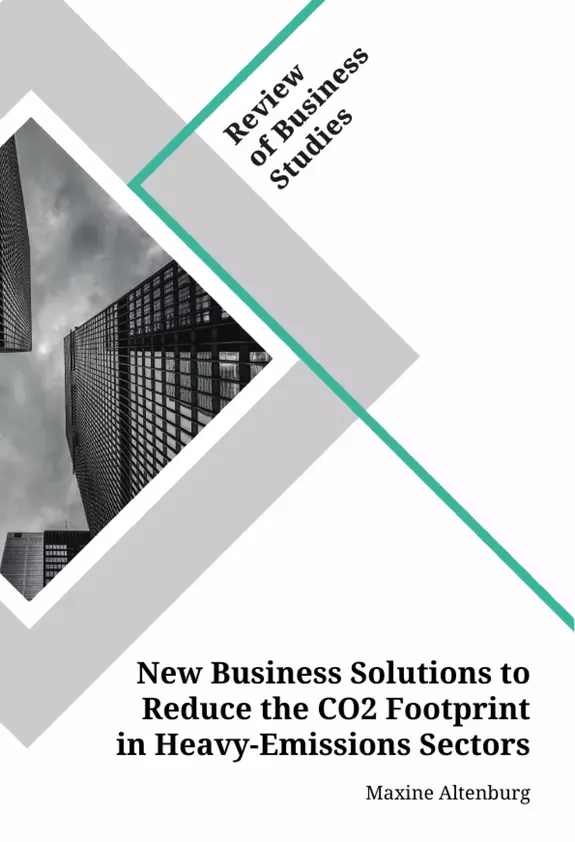Long-term effects and transformations due to further increasing greenhouse gas emissions will trigger irreversible and severe consequences for humans, their habitat and the nature. Governments will fail to reach the agreed emission reduction goals with their current measures and are consequently dependent on private sector involvement.
This study aims to provide a detailed overview of new business models that reduce the CO2 footprint in heavy-emissions sectors: Power Purchase Agreements, Energy Performance Contracting and Energy-as-a-Service. Various papers, market analysis and companies from multiple industries have been examined. Furthermore, a calculation of the future emissions savings potential for the German and global market is presented for each business model.
The findings demonstrate that each analyzed business model is suitable for companies from multiple sectors with particular characteristics. All instruments are providing improved carbon footprints, while the Energy-as-a-Service approach is predicted to reach the most extensive long-term impact. Based on these results, it is highly recommendable for suitable companies to apply at least one of the presented models to achieve emissions savings. For interested corporations, this thesis can serve as a starting point to critically analyze the suitability of the respective business solutions while understanding their future trends and development potentials.
Inhaltsverzeichnis (Table of Contents)
- Introduction
- Problem Presentation and Thesis Relevance
- State of Research
- Frequently Used Methods
- New Business Solutions
- Power Purchase Agreements
- Description of the Business Model
- Comparison of Different PPA Deal Structures
- Contributions and Limitations of the Model
- Potential Solutions to the Limitations
- Current State of Research, Regularities and Examples
- Scalability Potential
- Holistic Consideration Including Future Profitability
- Energy Performance Contracting
- Description of the Business Model
- Typical Process
- Contributions and Limitations of the Model
- Potential Solutions to the Limitations
- Current State of Research, Regularities and Examples
- Scalability Potential
- Holistic Consideration Including Future Profitability
- Energy-as-a-Service
- Description of the Business Solution as Holistic Approach
- Contributions, Limitations and Potential Solutions of the Model
- Current State of Research, Regularities and Examples
- Scalability Potential
- Holistic Consideration Including Future Profitability
- Discussion
- Future Outlook: Most Promising Approach
Zielsetzung und Themenschwerpunkte (Objectives and Key Themes)
This study aims to provide a comprehensive overview of new business models that reduce the CO2 footprint in heavy-emissions sectors: Power Purchase Agreements, Energy Performance Contracting and Energy-as-a-Service. The study examines various papers, market analysis and companies from multiple industries, and presents a calculation of the future emissions savings potential for the German and global market for each business model.
- Analysis of new business models for reducing CO2 emissions in heavy-emissions sectors
- Assessment of the contributions and limitations of each business model
- Evaluation of the scalability potential and future profitability of the models
- Comparison of the impact of each model on emissions reduction in the German and global markets
- Recommendations for the adoption of these models by companies seeking to reduce their emissions
Zusammenfassung der Kapitel (Chapter Summaries)
The introduction presents the problem of increasing greenhouse gas emissions and the need for private sector involvement in reducing them. The state of research chapter outlines frequently used methods for reducing emissions.
The new business solutions chapter examines three models in detail: Power Purchase Agreements, Energy Performance Contracting, and Energy-as-a-Service. Each section explores the model's description, contributions, limitations, potential solutions, current research, scalability potential, and holistic consideration including future profitability.
The discussion chapter provides a future outlook, highlighting the most promising approach.
Schlüsselwörter (Keywords)
The primary focus of this study lies on the reduction of the CO2 footprint in heavy-emissions sectors. The study examines new business models like Power Purchase Agreements, Energy Performance Contracting and Energy-as-a-Service. The main keywords are CO2 footprint, emissions reduction, business models, Power Purchase Agreements, Energy Performance Contracting, Energy-as-a-Service, scalability potential, future profitability, and emissions savings potential.
- Citar trabajo
- Maxine Altenburg (Autor), 2019, New Business Solutions to Reduce the CO2 Footprint in Heavy-Emissions Sectors, Múnich, GRIN Verlag, https://www.grin.com/document/540678



